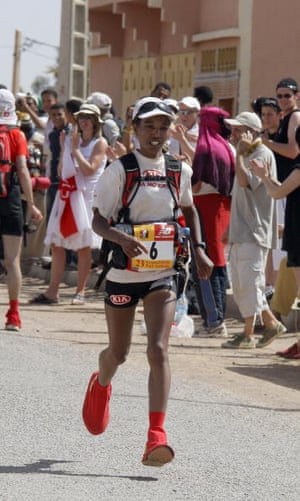International women’s team take on Marathon des Sables in world first
On 9 April, for the first time ever, an international women’s team will take their places on the start line of Morocco’s Marathon des Sables. The X-Bionic Women’s Team, supported by the charity Free to Run, will compete in the 250km run across the Sahara desert in the hope of inspiring more Moroccan women to take up running.
“There aren’t enough female role models in this sport and by coming together as a team we hope to help change that,” said Jenny Davis, team captain and driving force behind the project.
Davis will be joined in the desert by two highly talented Moroccan runners, Aziza Raji and Touda Didi. All three are accomplished ultra-marathoners and have been training hard in the Sahara for the six-day race.
The Marathon des Sables, or MdS, has long been established as one of the world’s most famous ultra-marathons. Although it might not quite live up to its claim to be “the toughest footrace on earth” (there are other candidates for this controversial title), its size and popularity make it a special event, as I discovered when I joined a thousand or so others shuffling across the desert in 2014.

The MdS’s popularity has not been limited to weekend warriors from the UK and France either, although they are by far the two largest participant nationalities. Over the years, it has also become a major national sporting event in its home country of Morocco. The famous Moroccan brothers, Lahcen and Mohamad Ahansal, have achieved national hero status after winning a staggering 15 victories between them.
So far, however, MdS has tended to be a heavily male-dominated event and has particularly struggled to attract participation from Moroccan women. In 2016, 15% of the field was female and there were only three Moroccan women out of a total 973 finishers. Admittedly, ultra-marathon participation in general tends to be weighted towards men but in other races the divide is smaller and, in many cases, shrinking further all the time.
The difference between the male and female winning times is also notable. Whereas in many long distance and multi-day events one will find a gap of perhaps 10-20% between male and female times on average, for MdS, the differential over the past five years has been more than 30%. There are numerous reasons for this, not least that the race requires runners to carry their kit – which is likely to be heavier in proportion to body weight for women. But the lack of “serious” female runners from Morocco – runners who might be more used to the terrain – is another.
Davis and her team are hoping to change this. Recognising that there are cultural and religious taboos surrounding women’s participation in sport, Team X-Bionic hope that their publicity can help to change attitudes and inspire a future generation of runners. Aziza Raji, who is aiming for a podium finish in the race, explained: “These opportunities are rare for women in Morocco. I have noticed remarkable progress in recent years for women’s rights and equality here. Having this women’s team bolsters that progress and I hope I can be considered a role model to other Moroccan women who are considering getting involved in running.”
The Free to Run charity, which “uses the power of sports to help women and girls overcome the harmful effects of conflict and discrimination”, has been helping to organise and promote the initiative. Previous examples of their work include setting up sports groups in refugee camps in South Sudan and helping women to participate in Afghanistan’s first marathon’. Founder Stephanie Case is confident that Team X-Bionic can succeed. “Having seen first hand the positive impact of our programs over the first two years of operation, I am even more convinced of the power of sports to change lives.”
You can support the team, and their plans to expand the initiative to races in other countries, at justgiving.com/fundraising/womensinternationalteam and you will be able to follow their progress in the Marathon des Sables from 9 April, or on Twitter at @XBWomensTeam
Source: Read Full Article


